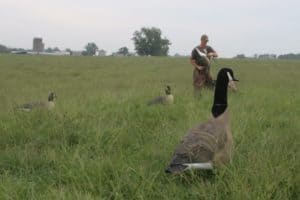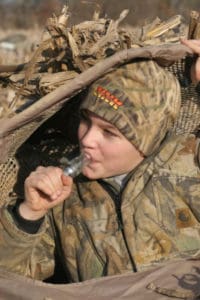by David Hart
America has a love-hate relationship with Canada geese.

Geese will feed in fields in the morning and then fly to water to loaf throughout the middle of the day. Find a pond or lake shore the birds are using, and set out a handful of floater decoys.
They are big, beautiful and graceful birds, and their migration symbolized the coming of autumn. At least that’s how it once was. These days, resident geese are like the unwelcome visitor that refuses to leave. They leave droppings everywhere they go, and their waste can foul ponds and fields alike. In many places, they are little more than 10-pound flying rats.
Hunters, however, have every reason to love what the rest of the world considers a pest.
Why not?
Resident Canada geese now live in nearly every state, and they provide abundant and accessible hunting opportunities.
Seasons in some states begin as early as mid-August. And because they are an unwelcome pest in so many places, many landowners are grateful someone is willing to rid their land of the messy birds.
Scout First
All that opportunity doesn’t mean killing a few geese is as simple as throwing out a few decoys.

Early season geese often feed in pastures, so don’t overlook large grass fields. Hiding can be difficult, but with a little effort, you can blend in well enough to fool the birds.
You have to find them first. In fact, scouting is critical for early season resident geese for a simple reason, says Minnesota resident and Avery Outdoors territory manager Mark Brendemuehl.
“They have fewer options this time of year. There isn’t as much corn cut, and the grain fields that have been harvested early often grow up in thick grass, so geese won’t use them,” he explains. “They are also creatures of habit, especially if they haven’t been hunted. They roost on the same water and loaf on the same ponds day after day. You have to find those spots they are using, otherwise you may be wasting your time.”
A Different Bird
Unlike late-season geese, resident Canadas often stay in family flocks of anywhere from just a few birds up to a dozen or so. They certainly can gather in large groups when they feed and loaf, but there’s no need to set out a massive decoy spread. In fact, big spreads can actually intimidate resident birds.
Brendemuehl has used as few as a half-dozen, but he tends to use up to two dozen, depending on what he sees during scouting trips. It’s important to mimic what the real birds are doing, he says.
“I think they are more willing to land among a dozen or so decoys than three dozen because it’s what they are used to,” he says.
Fields or Water

Because resident geese can be suckers for decoys, they are a great way to introduce young hunters to the thrill of waterfowling. Let the kids call. It probably won’t hurt anything.
The best place to hunt resident geese depends entirely on where they are feeding. Fields are always good, but this time of year, tossing out a handful of floating decoys on a farm pond can be deadly. Late-summer rains can rejuvenate pastures and Canada geese will flock to green grass. It’s one of their preferred foods and they’ll eat it well into the fall and early winter. That’s why ponds surrounded by grass can draw geese like few other places. The best ponds have low banks and no or little cover around the shoreline. That gives the birds a sense of security and it gives them the freedom to move onto to dry land at will.
“I hunted a pond that had nowhere to hide, but it was one of the best places I hunted. We just dug holes next to the water,” recalls Brendemuehl.
Because geese like to land on water and walk up on shore if given the opportunity, it’s a good idea to put some floating decoys in the water and some full-bodies on the shore. If there is no wind to bring the floating decoys to life, consider rigging some sort of jerk cord to coax wary geese into range.
The good news is that it often takes little coaxing to pull resident birds in close. Unless they’ve been hunted a few times, they are suckers for a decoy spread in the right place. Be patient, though, and choose your shots carefully.
“If you can, pick out the largest bird in the flock and shoot it first. It may be the adult in the group. If the rest are juveniles, there’s a good chance they’ll come back even after you knocked down a few on the first pass,” says Brendemuehl. “Sometimes it can seem too easy, but that makes up for all the hunts that aren’t.”
The Union Sportsmen’s Alliance website is designed to provide valuable articles about hunting, fishing and conservation for members of AFL-CIO affiliated labor unions and all sportsmen and sportswomen who appreciate hunting and fishing and want to preserve our outdoor heritage for future generations. If you would like your own story and experience from the outdoors to be considered for our website, please email us at [email protected].








